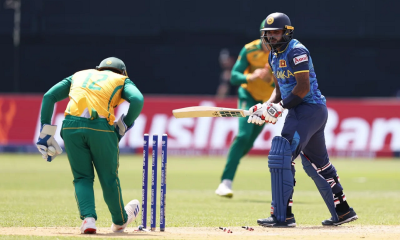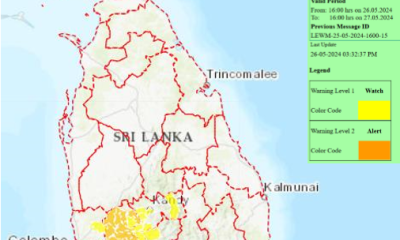Features
Debt Vs. Equity – A Case for More FDI and Private Ownership

By Chandu Epitawala
Since the unprecedented crisis in the country in 2022, many people (experts as well as laymen) have weighed in on what ails Sri Lanka in terms of its governance and macroeconomic failings and missteps which eventually led to the collapse of the economy, the currency and default on its debt. Many have also commented/highlighted the brain drain or migration of trained/skilled minds that is taking place or even accelerating. I like to dwell on a slightly different aspect/cause or focus on the same issue of the economy and its remedies purely from a Finance standpoint which I find not discussed widely enough in media and public/private fora.
As any student of Finance will tell you, studying for a Degree in Finance will lead you to three main career paths. Regular Banking (mostly specializing in Debt), Asset or Fund Management and Merchant Banking or Corporate Finance. I will attempt to look at Sri Lanka’s economic crisis and its possible solutions more from the vantage point of the Merchant Banker or purely from a financing point of view.
What are the essential or fundamental elements of a Country (or a Company) for it to efficiently or competitively function and thrive in a globalized economy? (Sri Lanka, in general, and the government entities/SOEs in particular, sadly lacks all these elements in varying degrees.)
A set of Physical Assets (investment)
A group of People (human capital/Expertise/Know How)
A governance/management Structure – Entrepreneurial Drive/Spirit
A Plan/Skill/Ability to sell/export/market the output (goods or services)
I will mainly focus on the challenge of how to put together the essential Public Infrastructure Assets (or restructure existing set of Assets/SOEs) to revive economic activity and fuel growth, as that’s the one which requires the bulk of financing. When one refers to Finance, what does that entail?
A set of Public Assets required to run a Country efficiently generally includes highly capital-intensive public infrastructure such as Roads/Highways, Sea Ports, Airports, Bridges, Power Generating/Distribution infrastructure, Irrigation Infrastructure, and Storage/Logistics Infrastructure etc. etc. I like to highlight the fact that this type of infrastructure requires some Government (State and Local) involvement, at least at the initial stage as investment (finance) required are quite high, involves macro/national or strategic planning, land acquisition, very long gestation period etc. However, the principles of financing such Projects are no different to Corporate Finance. In fact, at the country level, one may have even better options, such as borrowing at concessional rates or getting equity participation from multilateral agencies (Ex. IFC etc.)
As any Accounting, Banking, or Economics student would point out, at the simplest/elementary level, a set of Assets (which gets recorded in a Balance Sheet) can be financed only in one of two ways; Equity/Own Capital or Debt/Borrowed Capital. (However, many hybrid combinations and sophisticated variations are available, but that goes beyond the scope of this Note). Following is the basic equation of a Company Balance Sheet.
TOTAL ASSETS = DEBT (Borrowed Capital) + EQUITY CAPITAL (Ownership)
At the national or macro level, Sri Lankan capital accumulation/formation or total Savings (individual and corporate) in the Banking system is around 17% of the GDP. For Sri Lanka to achieve an 8% real annual growth rate, the Country needs around 30% of GDP in capital investment (including private investments in factories, housing, etc.) every year, including in Public Infrastructure, mostly undertaken by the Government. This leaves a significant 13% or so of GDP (nearly $6-8 billion every year) gap/shortfall in Financing required to fuel the annual growth required to provide adequate employment opportunities etc. This capital can only come from outside the Country or from the Savings of foreigners or citizens of other countries. Either we can borrow (Debt Financing) this Capital or try to attract Equity (FDI). From a macro perspective, it would be highly unwise to borrow in entirety such amounts from foreign sources even if can. The way to get out of our current predicament of unsustainable levels of government debt is aggressively canvassing for equity capital (foreign or local) in exchange for ownership transfer of government-owned Assets, thereby rebalancing the macro-level Capital Mix or Structure.
In Finance, there’s an important concept called the Optimal Capital Structure (where the Weighted Average Cost of Capital is the lowest). Any balance sheet must have the right mixture/balance of Debt and Equity to balance the above equation. It is not desirable to have too much Debt (borrowed capital) or Equity (own capital).
Debt in itself is not a bad thing as long as one knows the following;
How much to borrow (as a % of the Balance Sheet and certainty/riskiness of Turnover/Income)
On what terms (rate, repayment schedule, collateral required etc.)
How or Where to deploy the funds (in productive activity that gives a better return etc.)
Equity (FDI) is usually better (especially in the SL context, where we have borrowed too much on unfavourable terms and are now unable to repay). It should be welcomed, but ownership of those Assets will not be held by locals (ownership of the existing set of Assets need to be handed over to the investor/new owner), which in Sri Lanka appears to be a controversial and divisive topic due to lack of proper understanding of basics of Finance. In other words, purely from a Financing standpoint, it would have been much better if Sri Lanka (or any other country in our situation) were to get $3 Bn in FDI in exchange for ownership in a Sri Lankan SOE than the EFF Facility (debt or borrowing) from the IMF. The bulk of the foreign reserves of the country should be equity (FDI, Remittances, Tourism Receipts and Export Proceeds) and not borrowed dollars/euros. That would have warranted lighting firecrackers and celebrations. (Admittedly, IMF Program, with its monitoring mechanism, sends other important positive signals to the international community of lenders and investors and governments)
I want to state here a wise quote apparently made by the late Mr Upali Wijewardena; ” the ownership of a set of Assets is not important. What is important is having access to or the users of those Assets”. This rationale/logic would apply equally to corporates or individuals. The reason is ownership comes with investing/blocking a sum of money (which always has opportunities elsewhere or opportunity cost), and if Sri Lankan taxpayers (or anyone else for that matter) can have access/users to a business, service, infrastructure without doing the investment ourselves/utilizing our own equity funds, why not? Do we care who owns a business/set of assets?
I would take Hambantota Port (HIP) as an example which drew much condemnation and protest from sections of the Sri Lankan public against Foreign Investment/Ownership to illustrate the point. There should be no argument that the Chinese Investor has far better worldwide connections/network, port/logistics management expertise and deep pockets to continuously invest and improve the HIP and surrounding infrastructure than Sri Lanka Ports Authority or GoSL. The GoSL oversees the Security of the Port, Customs duties, and Immigration.
Only the commercial aspects are handled by the Chinese investor. SL exporters and importers have access to or are the users of a modern, efficient Harbour. I do not see any reason for Sri Lankans to complain (other than on the terms of the Sale, which is a done deal). From a Finance standpoint, it’s essentially a Debt Equity swap. SLPA (or GoSL) balance sheet, Debt came down, and ownership or management control on a lease was transferred to the Chinese party for 99 years. That Asset (or set of assets) cannot be removed from our sovereign soil and thus comes forever under the SL Ports regulator. What’s more, any income/profits derived from an efficient operation can be taxed, and the SLPA/GoSL charges fees/levies.
Many other examples, such as Sri Lanka Telecom (SLT) and Lanka Indian Oil Company, can be given from our own country. Numerous examples can be given from all over the world, especially India, Malaysia etc. Remember, unlike when loans are taken when foreign equity is committed to the country, the periodic forex outflow from the country is part of the dividends paid out to the owning/controlling entity, and that is only when the business is profitable/thriving.
Ownership of Assets/Businesses change hands all the time on a daily basis (Ex. The Stock Markets) in the real world, and that is nothing to fear. Companies regularly make in-house or outsourced decisions/choices. Individuals are often called upon to make own, hire/lease/rent choices. In fact, anyone who understands the basics of Finance should welcome equity financing (as opposed to excessive debt financing) and welcome more and more FDI giving up government or private ownership (along with risks, challenges such as finding export markets/clients, maintenance/upkeep and other headaches) and enjoy the benefits (users and access) of efficiently run, thriving business operations (Power, Energy, Ports, Telecom, or whatever) by foreigners or even aliens functioning from our soil and servicing our people and paying their due taxes and fees.
If Sri Lanka were to fully open up the country and create the necessary conditions, such as maintaining the rule of law and policy consistency, to attract/welcome foreign equity capital (FDI) and foreign human talent/know-how/expertise ( Entrepreneurial, Managerial, Technical and Creative) like had been aggressively done and still being pursued in Dubai and Singapore and many other places like Panama, Malaysia, Thailand etc., Sri Lanka can not only come out of this crisis but also somewhat mitigate or even reverse the ill effects from the brain drain that is taking place. I
t would be a grave mistake to assume we Lankans have all the requisite talent/expertise to run globally competitive businesses or can do everything better. Believe it or not, though those who are born and bred in Sri Lanka may be eager to migrate to the West looking for greener pastures, there are many in the West (and in other countries) with specific skills/talent/expertise we badly need, and with capital we lack who would consider moving here (or merely investing here) on a long term basis if the right conditions as mentioned above are created and available. Again, nothing for locals to fear as such opening up only would create vibrant, thriving businesses and an economy which in turn creates many employment and other opportunities for locals from which locals will gradually learn and acquire the know-how/expertise over time, not to mention the potentially large tax revenues for the government.
To reiterate, from an economic and financial point of view and indeed a commonsense point of view, Ownership/Control is unimportant. Enjoy the access and users while allowing the government to foster competition, regulate and tax these entities/businesses and pass on the benefits or redistribute such revenues to the public/masses by enhancing and expanding free health care and education, welfare programs and the like.
.
Features
The heart-friendly health minister

by Dr Gotabhya Ranasinghe
Senior Consultant Cardiologist
National Hospital Sri Lanka
When we sought a meeting with Hon Dr. Ramesh Pathirana, Minister of Health, he graciously cleared his busy schedule to accommodate us. Renowned for his attentive listening and deep understanding, Minister Pathirana is dedicated to advancing the health sector. His openness and transparency exemplify the qualities of an exemplary politician and minister.
Dr. Palitha Mahipala, the current Health Secretary, demonstrates both commendable enthusiasm and unwavering support. This combination of attributes makes him a highly compatible colleague for the esteemed Minister of Health.
Our discussion centered on a project that has been in the works for the past 30 years, one that no other minister had managed to advance.
Minister Pathirana, however, recognized the project’s significance and its potential to revolutionize care for heart patients.
The project involves the construction of a state-of-the-art facility at the premises of the National Hospital Colombo. The project’s location within the premises of the National Hospital underscores its importance and relevance to the healthcare infrastructure of the nation.
This facility will include a cardiology building and a tertiary care center, equipped with the latest technology to handle and treat all types of heart-related conditions and surgeries.
Securing funding was a major milestone for this initiative. Minister Pathirana successfully obtained approval for a $40 billion loan from the Asian Development Bank. With the funding in place, the foundation stone is scheduled to be laid in September this year, and construction will begin in January 2025.
This project guarantees a consistent and uninterrupted supply of stents and related medications for heart patients. As a result, patients will have timely access to essential medical supplies during their treatment and recovery. By securing these critical resources, the project aims to enhance patient outcomes, minimize treatment delays, and maintain the highest standards of cardiac care.
Upon its fruition, this monumental building will serve as a beacon of hope and healing, symbolizing the unwavering dedication to improving patient outcomes and fostering a healthier society.We anticipate a future marked by significant progress and positive outcomes in Sri Lanka’s cardiovascular treatment landscape within the foreseeable timeframe.
Features
A LOVING TRIBUTE TO JESUIT FR. ALOYSIUS PIERIS ON HIS 90th BIRTHDAY

by Fr. Emmanuel Fernando, OMI
Jesuit Fr. Aloysius Pieris (affectionately called Fr. Aloy) celebrated his 90th birthday on April 9, 2024 and I, as the editor of our Oblate Journal, THE MISSIONARY OBLATE had gone to press by that time. Immediately I decided to publish an article, appreciating the untiring selfless services he continues to offer for inter-Faith dialogue, the renewal of the Catholic Church, his concern for the poor and the suffering Sri Lankan masses and to me, the present writer.
It was in 1988, when I was appointed Director of the Oblate Scholastics at Ampitiya by the then Oblate Provincial Fr. Anselm Silva, that I came to know Fr. Aloy more closely. Knowing well his expertise in matters spiritual, theological, Indological and pastoral, and with the collaborative spirit of my companion-formators, our Oblate Scholastics were sent to Tulana, the Research and Encounter Centre, Kelaniya, of which he is the Founder-Director, for ‘exposure-programmes’ on matters spiritual, biblical, theological and pastoral. Some of these dimensions according to my view and that of my companion-formators, were not available at the National Seminary, Ampitiya.
Ever since that time, our Oblate formators/ accompaniers at the Oblate Scholasticate, Ampitiya , have continued to send our Oblate Scholastics to Tulana Centre for deepening their insights and convictions regarding matters needed to serve the people in today’s context. Fr. Aloy also had tried very enthusiastically with the Oblate team headed by Frs. Oswald Firth and Clement Waidyasekara to begin a Theologate, directed by the Religious Congregations in Sri Lanka, for the contextual formation/ accompaniment of their members. It should very well be a desired goal of the Leaders / Provincials of the Religious Congregations.
Besides being a formator/accompanier at the Oblate Scholasticate, I was entrusted also with the task of editing and publishing our Oblate journal, ‘The Missionary Oblate’. To maintain the quality of the journal I continue to depend on Fr. Aloy for his thought-provoking and stimulating articles on Biblical Spirituality, Biblical Theology and Ecclesiology. I am very grateful to him for his generous assistance. Of late, his writings on renewal of the Church, initiated by Pope St. John XX111 and continued by Pope Francis through the Synodal path, published in our Oblate journal, enable our readers to focus their attention also on the needed renewal in the Catholic Church in Sri Lanka. Fr. Aloy appreciated very much the Synodal path adopted by the Jesuit Pope Francis for the renewal of the Church, rooted very much on prayerful discernment. In my Religious and presbyteral life, Fr.Aloy continues to be my spiritual animator / guide and ongoing formator / acccompanier.
Fr. Aloysius Pieris, BA Hons (Lond), LPh (SHC, India), STL (PFT, Naples), PhD (SLU/VC), ThD (Tilburg), D.Ltt (KU), has been one of the eminent Asian theologians well recognized internationally and one who has lectured and held visiting chairs in many universities both in the West and in the East. Many members of Religious Congregations from Asian countries have benefited from his lectures and guidance in the East Asian Pastoral Institute (EAPI) in Manila, Philippines. He had been a Theologian consulted by the Federation of Asian Bishops’ Conferences for many years. During his professorship at the Gregorian University in Rome, he was called to be a member of a special group of advisers on other religions consulted by Pope Paul VI.
Fr. Aloy is the author of more than 30 books and well over 500 Research Papers. Some of his books and articles have been translated and published in several countries. Among those books, one can find the following: 1) The Genesis of an Asian Theology of Liberation (An Autobiographical Excursus on the Art of Theologising in Asia, 2) An Asian Theology of Liberation, 3) Providential Timeliness of Vatican 11 (a long-overdue halt to a scandalous millennium, 4) Give Vatican 11 a chance, 5) Leadership in the Church, 6) Relishing our faith in working for justice (Themes for study and discussion), 7) A Message meant mainly, not exclusively for Jesuits (Background information necessary for helping Francis renew the Church), 8) Lent in Lanka (Reflections and Resolutions, 9) Love meets wisdom (A Christian Experience of Buddhism, 10) Fire and Water 11) God’s Reign for God’s poor, 12) Our Unhiddden Agenda (How we Jesuits work, pray and form our men). He is also the Editor of two journals, Vagdevi, Journal of Religious Reflection and Dialogue, New Series.
Fr. Aloy has a BA in Pali and Sanskrit from the University of London and a Ph.D in Buddhist Philosophy from the University of Sri Lankan, Vidyodaya Campus. On Nov. 23, 2019, he was awarded the prestigious honorary Doctorate of Literature (D.Litt) by the Chancellor of the University of Kelaniya, the Most Venerable Welamitiyawe Dharmakirthi Sri Kusala Dhamma Thera.
Fr. Aloy continues to be a promoter of Gospel values and virtues. Justice as a constitutive dimension of love and social concern for the downtrodden masses are very much noted in his life and work. He had very much appreciated the commitment of the late Fr. Joseph (Joe) Fernando, the National Director of the Social and Economic Centre (SEDEC) for the poor.
In Sri Lanka, a few religious Congregations – the Good Shepherd Sisters, the Christian Brothers, the Marist Brothers and the Oblates – have invited him to animate their members especially during their Provincial Congresses, Chapters and International Conferences. The mainline Christian Churches also have sought his advice and followed his seminars. I, for one, regret very much, that the Sri Lankan authorities of the Catholic Church –today’s Hierarchy—- have not sought Fr.
Aloy’s expertise for the renewal of the Catholic Church in Sri Lanka and thus have not benefited from the immense store of wisdom and insight that he can offer to our local Church while the Sri Lankan bishops who governed the Catholic church in the immediate aftermath of the Second Vatican Council (Edmund Fernando OMI, Anthony de Saram, Leo Nanayakkara OSB, Frank Marcus Fernando, Paul Perera,) visited him and consulted him on many matters. Among the Tamil Bishops, Bishop Rayappu Joseph was keeping close contact with him and Bishop J. Deogupillai hosted him and his team visiting him after the horrible Black July massacre of Tamils.
Features
A fairy tale, success or debacle

Sri Lanka-Singapore Free Trade Agreement
By Gomi Senadhira
senadhiragomi@gmail.com
“You might tell fairy tales, but the progress of a country cannot be achieved through such narratives. A country cannot be developed by making false promises. The country moved backward because of the electoral promises made by political parties throughout time. We have witnessed that the ultimate result of this is the country becoming bankrupt. Unfortunately, many segments of the population have not come to realize this yet.” – President Ranil Wickremesinghe, 2024 Budget speech
Any Sri Lankan would agree with the above words of President Wickremesinghe on the false promises our politicians and officials make and the fairy tales they narrate which bankrupted this country. So, to understand this, let’s look at one such fairy tale with lots of false promises; Ranil Wickremesinghe’s greatest achievement in the area of international trade and investment promotion during the Yahapalana period, Sri Lanka-Singapore Free Trade Agreement (SLSFTA).
It is appropriate and timely to do it now as Finance Minister Wickremesinghe has just presented to parliament a bill on the National Policy on Economic Transformation which includes the establishment of an Office for International Trade and the Sri Lanka Institute of Economics and International Trade.
Was SLSFTA a “Cleverly negotiated Free Trade Agreement” as stated by the (former) Minister of Development Strategies and International Trade Malik Samarawickrama during the Parliamentary Debate on the SLSFTA in July 2018, or a colossal blunder covered up with lies, false promises, and fairy tales? After SLSFTA was signed there were a number of fairy tales published on this agreement by the Ministry of Development Strategies and International, Institute of Policy Studies, and others.
However, for this article, I would like to limit my comments to the speech by Minister Samarawickrama during the Parliamentary Debate, and the two most important areas in the agreement which were covered up with lies, fairy tales, and false promises, namely: revenue loss for Sri Lanka and Investment from Singapore. On the other important area, “Waste products dumping” I do not want to comment here as I have written extensively on the issue.
1. The revenue loss
During the Parliamentary Debate in July 2018, Minister Samarawickrama stated “…. let me reiterate that this FTA with Singapore has been very cleverly negotiated by us…. The liberalisation programme under this FTA has been carefully designed to have the least impact on domestic industry and revenue collection. We have included all revenue sensitive items in the negative list of items which will not be subject to removal of tariff. Therefore, 97.8% revenue from Customs duty is protected. Our tariff liberalisation will take place over a period of 12-15 years! In fact, the revenue earned through tariffs on goods imported from Singapore last year was Rs. 35 billion.
The revenue loss for over the next 15 years due to the FTA is only Rs. 733 million– which when annualised, on average, is just Rs. 51 million. That is just 0.14% per year! So anyone who claims the Singapore FTA causes revenue loss to the Government cannot do basic arithmetic! Mr. Speaker, in conclusion, I call on my fellow members of this House – don’t mislead the public with baseless criticism that is not grounded in facts. Don’t look at petty politics and use these issues for your own political survival.”
I was surprised to read the minister’s speech because an article published in January 2018 in “The Straits Times“, based on information released by the Singaporean Negotiators stated, “…. With the FTA, tariff savings for Singapore exports are estimated to hit $10 million annually“.
As the annual tariff savings (that is the revenue loss for Sri Lanka) calculated by the Singaporean Negotiators, Singaporean $ 10 million (Sri Lankan rupees 1,200 million in 2018) was way above the rupees’ 733 million revenue loss for 15 years estimated by the Sri Lankan negotiators, it was clear to any observer that one of the parties to the agreement had not done the basic arithmetic!
Six years later, according to a report published by “The Morning” newspaper, speaking at the Committee on Public Finance (COPF) on 7th May 2024, Mr Samarawickrama’s chief trade negotiator K.J. Weerasinghehad had admitted “…. that forecasted revenue loss for the Government of Sri Lanka through the Singapore FTA is Rs. 450 million in 2023 and Rs. 1.3 billion in 2024.”
If these numbers are correct, as tariff liberalisation under the SLSFTA has just started, we will pass Rs 2 billion very soon. Then, the question is how Sri Lanka’s trade negotiators made such a colossal blunder. Didn’t they do their basic arithmetic? If they didn’t know how to do basic arithmetic they should have at least done their basic readings. For example, the headline of the article published in The Straits Times in January 2018 was “Singapore, Sri Lanka sign FTA, annual savings of $10m expected”.
Anyway, as Sri Lanka’s chief negotiator reiterated at the COPF meeting that “…. since 99% of the tariffs in Singapore have zero rates of duty, Sri Lanka has agreed on 80% tariff liberalisation over a period of 15 years while expecting Singapore investments to address the imbalance in trade,” let’s turn towards investment.
Investment from Singapore
In July 2018, speaking during the Parliamentary Debate on the FTA this is what Minister Malik Samarawickrama stated on investment from Singapore, “Already, thanks to this FTA, in just the past two-and-a-half months since the agreement came into effect we have received a proposal from Singapore for investment amounting to $ 14.8 billion in an oil refinery for export of petroleum products. In addition, we have proposals for a steel manufacturing plant for exports ($ 1 billion investment), flour milling plant ($ 50 million), sugar refinery ($ 200 million). This adds up to more than $ 16.05 billion in the pipeline on these projects alone.
And all of these projects will create thousands of more jobs for our people. In principle approval has already been granted by the BOI and the investors are awaiting the release of land the environmental approvals to commence the project.
I request the Opposition and those with vested interests to change their narrow-minded thinking and join us to develop our country. We must always look at what is best for the whole community, not just the few who may oppose. We owe it to our people to courageously take decisions that will change their lives for the better.”
According to the media report I quoted earlier, speaking at the Committee on Public Finance (COPF) Chief Negotiator Weerasinghe has admitted that Sri Lanka was not happy with overall Singapore investments that have come in the past few years in return for the trade liberalisation under the Singapore-Sri Lanka Free Trade Agreement. He has added that between 2021 and 2023 the total investment from Singapore had been around $162 million!
What happened to those projects worth $16 billion negotiated, thanks to the SLSFTA, in just the two-and-a-half months after the agreement came into effect and approved by the BOI? I do not know about the steel manufacturing plant for exports ($ 1 billion investment), flour milling plant ($ 50 million) and sugar refinery ($ 200 million).
However, story of the multibillion-dollar investment in the Petroleum Refinery unfolded in a manner that would qualify it as the best fairy tale with false promises presented by our politicians and the officials, prior to 2019 elections.
Though many Sri Lankans got to know, through the media which repeatedly highlighted a plethora of issues surrounding the project and the questionable credentials of the Singaporean investor, the construction work on the Mirrijiwela Oil Refinery along with the cement factory began on the24th of March 2019 with a bang and Minister Ranil Wickremesinghe and his ministers along with the foreign and local dignitaries laid the foundation stones.
That was few months before the 2019 Presidential elections. Inaugurating the construction work Prime Minister Ranil Wickremesinghe said the projects will create thousands of job opportunities in the area and surrounding districts.
The oil refinery, which was to be built over 200 acres of land, with the capacity to refine 200,000 barrels of crude oil per day, was to generate US$7 billion of exports and create 1,500 direct and 3,000 indirect jobs. The construction of the refinery was to be completed in 44 months. Four years later, in August 2023 the Cabinet of Ministers approved the proposal presented by President Ranil Wickremesinghe to cancel the agreement with the investors of the refinery as the project has not been implemented! Can they explain to the country how much money was wasted to produce that fairy tale?
It is obvious that the President, ministers, and officials had made huge blunders and had deliberately misled the public and the parliament on the revenue loss and potential investment from SLSFTA with fairy tales and false promises.
As the president himself said, a country cannot be developed by making false promises or with fairy tales and these false promises and fairy tales had bankrupted the country. “Unfortunately, many segments of the population have not come to realize this yet”.
(The writer, a specialist and an activist on trade and development issues . )
























